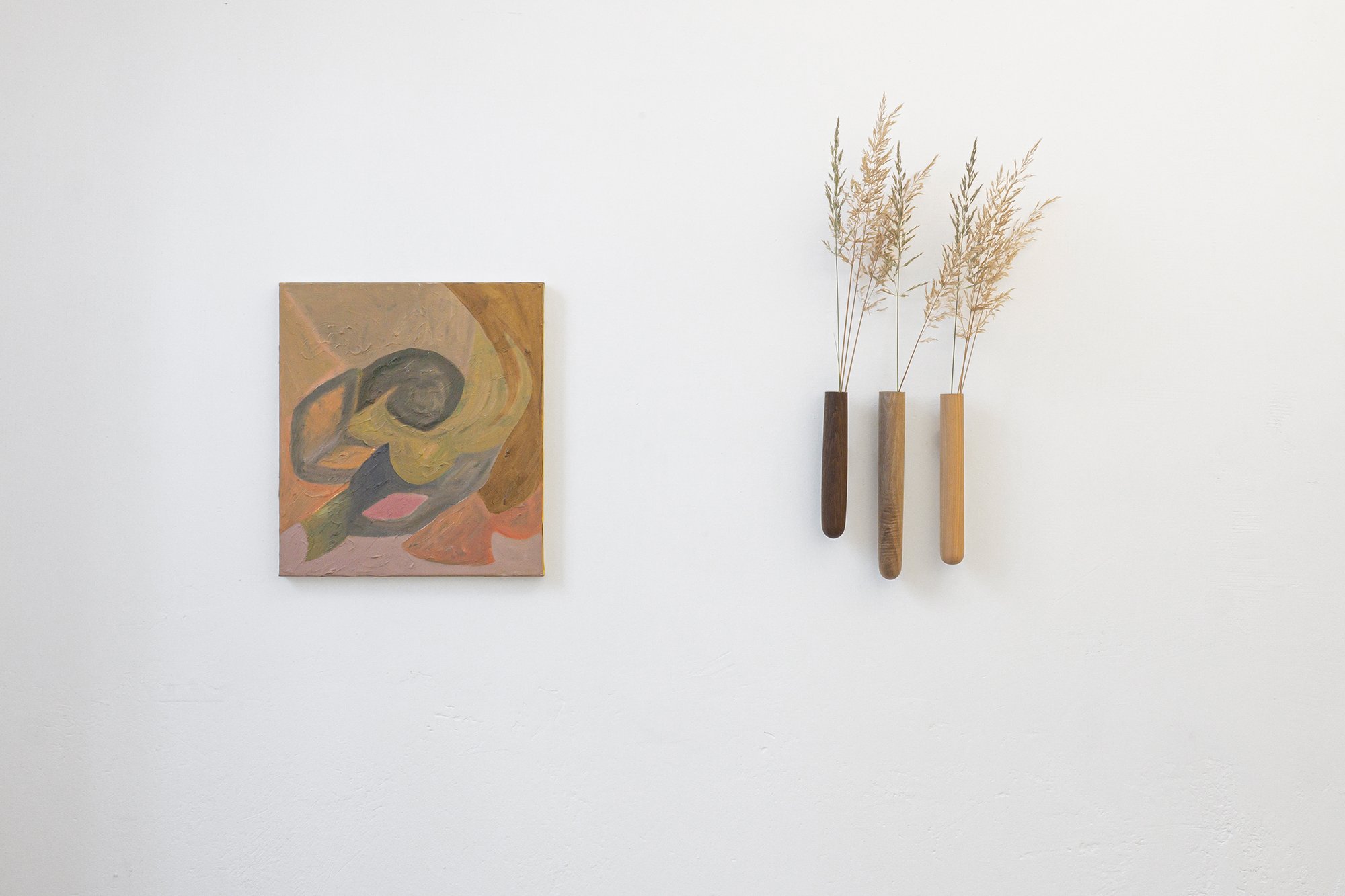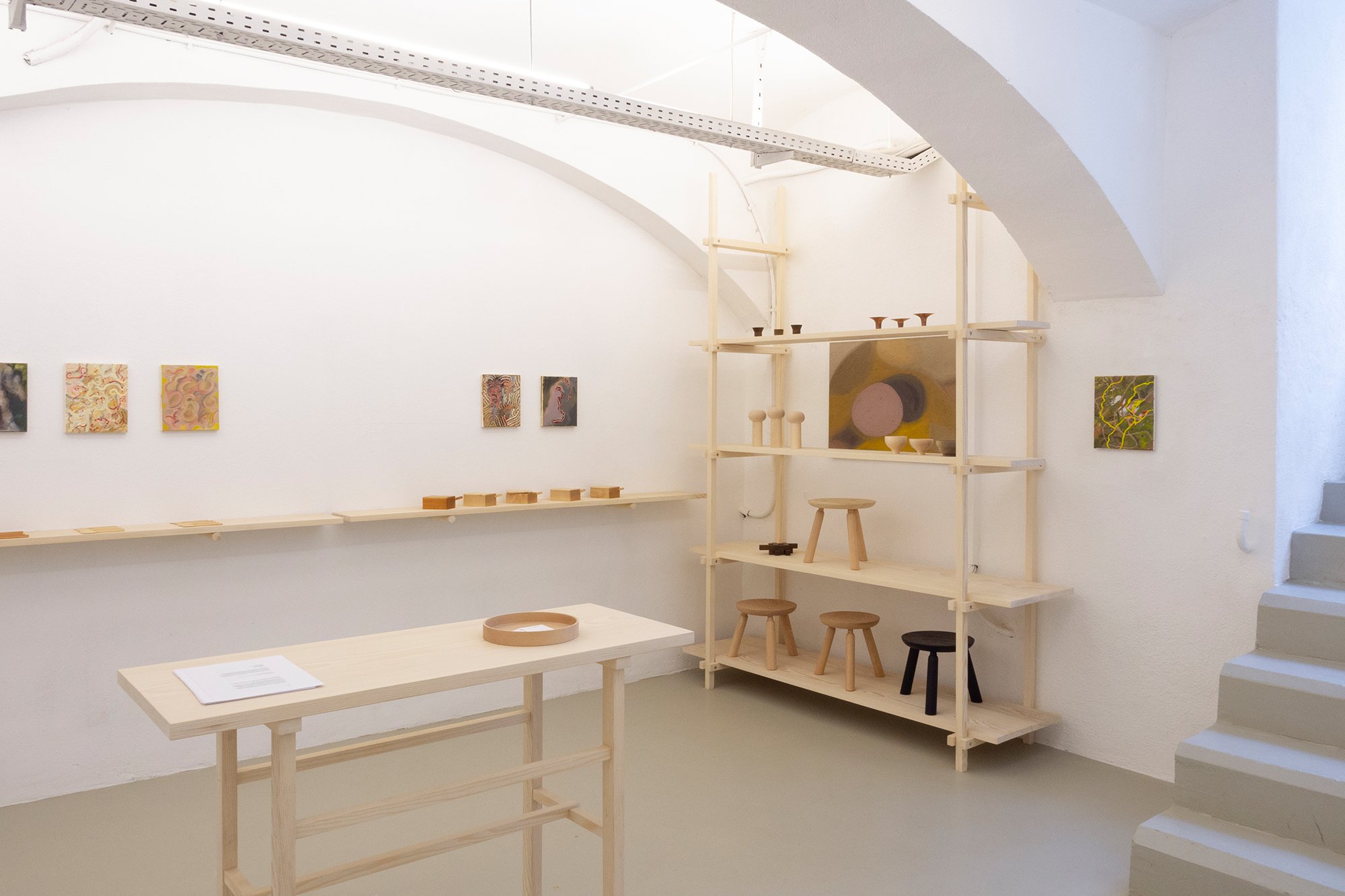painting for a chair
Aito in conversation with Elisa Bergmann
Since meeting Elisa Bergmann, we have been interested in her artistic practice and her approach to design. So it felt only natural to do the first exhibition at Aito Schauraum with the South Tyrolean painter. We sat down to reflect on the experience of creating the show together, the relationship between art and design and the importance of taking time.
Aito
Let’s start with the window display. Located on a quiet street in Vienna’s 8th district, the shop window felt a bit shy and hiding. We decided to open up this space for artistic experimentation, to encourage a dialogue between the interior and the exterior of the workshop, the public and private. Could you talk a bit about the ideas and process behind the installation in the window?
Bergmann
We knew finished works were going to be exhibited in the Schauraum. So with the shop window, we wanted to focus on the process of our practices and create a space together. After engaging with the architecture of the vitrine space, its various dimensions and perspectives, we made the print bow from the window up to the ceiling element. We inserted lamps which hang from the ceiling and the objects installed created some kind of landscape, and somehow it felt like a three-dimensional invitation for the exhibition. Wood-turned objects from Jakob helped create this in-between, ambiguous moment where it isn’t clear what the pieces are going to become or if they are already finished. The digital print with its abstract colour spaces, overlapping layers and texture of painting, also provokes this feeling of confusion.
Aito
We like how the installation tries to dissolve the boundaries between medium, form and material. It was also interesting that the arrangement took a variety of directions and evolved over a few weeks. That the public could experience our musings and deliberations.
Bergmann
…having the time to get to know the space, this process of working on the shop window, was so essential for doing the show in the Schauraum. Already having a good connection about aesthetics and what atmosphere we wanted to create. We kept being open for feedback and trying out new ideas throughout a long ping-pong process.
Aito
You created some new works for the show, like das Bild im Raum and the butt is smart, where Aito forms inspired lines and shapes. How did you make the final selection of the paintings for the exhibition?
Bergmann
I think a lot about rhythm when hanging or choosing paintings. I like these harmonic moments but I like it even more when there’s a clash and something unexpected like the screaming pink of die Tage sind kurz, das Leben ist lang occurs.
Aito
Aito objects have this quietness which stems from the simplification of form, but this simplicity lends the designs a sense of warmth and approachability. We really enjoyed these loud moments…to experience the colours of the paintings engage with the objects, their tactility and the natural materials.
Bergmann
Textures and surfaces were something I was also very interested in – how the objects would be in dialogue with the paintings. Because I see many of the objects as characters, like the pepper mills for example – they are like creatures or a little city.
We also didn’t want to just show the paintings alongside the objects. But combine them, to create these installation moments. For me, how the objects are installed in the room with painting is a bit like punctuation marks – Das Bild in Raum and the three vases together - it’s almost like a sentence. And with the painting, the butt is smart, I like how it became part of the shelf and the interior architecture.
Aito
In our conversations we spoke about the line that is typically drawn between art and design.
Bergmann
The line became more complex when it came to defining the value through a price. It’s this strange mystification, especially of painting and sculpture, but I feel that having a list of prices kills so much. Our solution in the end was to sell the pieces together, for example a set with a painting and three vases, which also reflected the way we collaborated. Not separating but blurring the boundaries between art and design.
Aito
Furniture appears in some of your works and you did a show called quiet legs. What was your inspiration for the exhibition title ‘Painting for a chair’?
Bergmann
I was working on a bigger format painting for some weeks and would often sit down on a chair. And before I left the studio I would always turn back to have a last look at the painting. There was always this empty chair standing in front of the painting and it felt almost like the painting is for this empty chair. So this was a working title and I thought it actually fits quite well for the show.
Elisa Bergmann, born 1990, lives and works in Vienna. Studied at the Faculty of Art and Design in Bolzano, at the Academy of Fine Arts in Vienna and at the Institute of Technology and Design in St. Petersburg. Her works have been exhibited in Fortress Franzensfeste, Italy; Gallery 5020, Salzburg; Room D, Museumsquartier Vienna; Kunsthalle Bozen, Bolzano; Plan-Raum für Kunst, Hamburg; Galerie Prawneg & Wolf, Bruneck; Galerie Prisma, Bozen.

photos: Eva Engelbert



Mit freundlicher unterstützung von:





